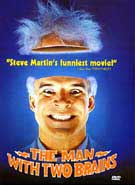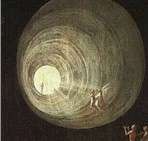 In The Mystical Mind: Probing the Biology of Religous Experience, Eugene d’Aquili and Andrew Newberg (picture) sketch out their framework for neurotheology. Famous for their neuroimaging studies of meditating monks and praying nuns, the pair’s work is considered ground-breaking. None other than Fraser Watts lauds their ideas as “the best available neuropsychological theory of religion,” and Publisher’s Weekly called the book “exhilarating” and “fascinating”. Not content to just illuminate the biological aspects of religion, the researchers conclude their book with a discussion of how neurotheology could serve as the basis for a “metatheology” or even a “megatheology”. At the same time, they assiduously maintain a facade of evenhandedness, claiming not to know or even care whether God really exists, and stridently denying anything reductionist about their approach. It’s like saying you’re going to study the Man in the Moon, then professing complete ignorance about whether he actually exists or not, claiming that you are just studying the lunar features that may or may not constitute his face.
In The Mystical Mind: Probing the Biology of Religous Experience, Eugene d’Aquili and Andrew Newberg (picture) sketch out their framework for neurotheology. Famous for their neuroimaging studies of meditating monks and praying nuns, the pair’s work is considered ground-breaking. None other than Fraser Watts lauds their ideas as “the best available neuropsychological theory of religion,” and Publisher’s Weekly called the book “exhilarating” and “fascinating”. Not content to just illuminate the biological aspects of religion, the researchers conclude their book with a discussion of how neurotheology could serve as the basis for a “metatheology” or even a “megatheology”. At the same time, they assiduously maintain a facade of evenhandedness, claiming not to know or even care whether God really exists, and stridently denying anything reductionist about their approach. It’s like saying you’re going to study the Man in the Moon, then professing complete ignorance about whether he actually exists or not, claiming that you are just studying the lunar features that may or may not constitute his face.
If this book represents the state-of-the-art in neurotheology, we are in deep trouble. It’s intellectually sloppy, disorganized, selective, and unscientific.
The problems start with the book’s title, and the word “mind” used therein, which the authors admit they have no idea how to define. They say, “The mind is the name for the intangible realities that the brain produces.” They don’t do much better with the word “mystical” in the title, giving new meaning to the word circularity with their definition that “the idea that the brain and mind are mystical suggests that the function of the brain and mind can lead to mystical experiences.” They then bounce to the idea that the mind/brain is just, well, intrinsically mystical.
But perhaps those are just semantic quibbles. The problems deepen when they start actually laying out theories, starting with the so-called “cognitive operators.” These are
primary functional components of the mind, specific functions that specific [unspecified] parts of the brain perform as part of the mind..analogous to the operators used in mathematics. The functioning of the cognitive operators is what produces a sense of “mind.” The brain structures and neurons that work to generate the functions of the operators are part of the overall structure and function of the brain. Thus brain function results in the function of the cognitive operators and therefore results in the function of the mind.
I quote at length to demonstrate the utter incoherence of their writing.
The seven primary cognitive operators that “comprise the most basic functions of the mind” are:
- holistic
- reductionist
- causal
- abstractive
- binary
- quantitative
- emotional
Newberg and d’Aquili present no justification for these operators—they are made up out of thin air. They provide no neural correlates of them. They present no evidence that any of these actually exist, or that their list is comprehensive. One can only conclude that they worked backward to come up with these particular operators. Let’s see, we have transcendant states, so there must a holistic operator; we have images of God as the ultimate mover, so that would need a causal operator; primitive myths involve good and evil so let’s put in a binary operator.
I think phrenology would probably do at least as good a job of helping us understand religion as these made-up operators.
In a future post, I will review Newberg and d’Aquili’s specific theories as to the neurophysiology of (one kind of) religious experience.
 A group of Chinese researchers has studied go players using fMRIs. The experimental design had the subjects looking at an empty board, a board with randomly placed stones, and a real game position.
A group of Chinese researchers has studied go players using fMRIs. The experimental design had the subjects looking at an empty board, a board with randomly placed stones, and a real game position.
 In
In  Children respond easily and naturally to the concept of God. They assume his omniscience, for instance, as a matter of course. In one study which asked children what kinds of beings could know everything, specifically what was in a closed box, 5 and 6-year-olds answered that only God and an orange kitty with special vision could. They had already figured out that their mothers did not know everything (which is what the 3 and 4-year-olds had believed). Other studies have shown that children associate God with the creation of natural objects, as opposed to the humans who create artificial objects. Yet additional studies in cultures with a hierarchy of supernatural beings showed the children could order the beings by their power, from God on down to the sun and rocks. Most studies contradict the notion that children build their notions of God as superpowerful versions of their parents.
Children respond easily and naturally to the concept of God. They assume his omniscience, for instance, as a matter of course. In one study which asked children what kinds of beings could know everything, specifically what was in a closed box, 5 and 6-year-olds answered that only God and an orange kitty with special vision could. They had already figured out that their mothers did not know everything (which is what the 3 and 4-year-olds had believed). Other studies have shown that children associate God with the creation of natural objects, as opposed to the humans who create artificial objects. Yet additional studies in cultures with a hierarchy of supernatural beings showed the children could order the beings by their power, from God on down to the sun and rocks. Most studies contradict the notion that children build their notions of God as superpowerful versions of their parents.
 Researchers have built a computer model which replicates our human ability to learn rules and use them to control ourselves—which scientists call “cognitive control”. Cognitive control is how we mold and channel our thoughts and actions to reach some goal. The prefrontal cortext (PFC) is a key player in cognitive control.
Researchers have built a computer model which replicates our human ability to learn rules and use them to control ourselves—which scientists call “cognitive control”. Cognitive control is how we mold and channel our thoughts and actions to reach some goal. The prefrontal cortext (PFC) is a key player in cognitive control. Neuroscience is rapidly permeating popular culture. Proof in point: Jim Holt’s recent New York Times Magazine article,
Neuroscience is rapidly permeating popular culture. Proof in point: Jim Holt’s recent New York Times Magazine article,  Look up the word “think” in an English-Japanese dictionary and you’ll find two main alternatives: “kangaeru” and “omou”.
Look up the word “think” in an English-Japanese dictionary and you’ll find two main alternatives: “kangaeru” and “omou”. Students of neurotheology study
Students of neurotheology study  Full moon overhead
Full moon overhead